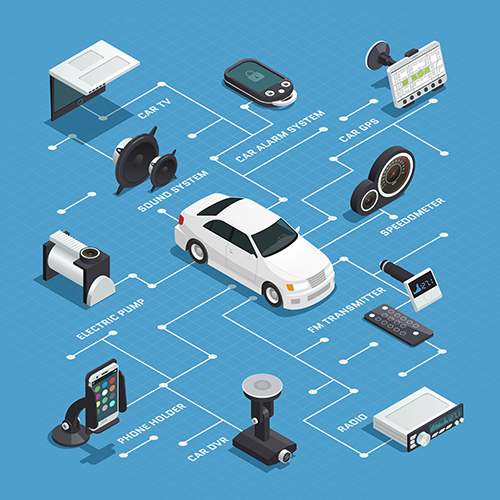Tactile sensors will give cars a sense of touch, letting them understand the road, and improve safety and autonomy.

In the race towards fully autonomous vehicles, the automotive industry is witnessing a surge of innovation aimed at enhancing both vehicle intelligence and autonomy. Diverse features ranging from cloud connectivity to advanced driver assistance systems (ADAS) belong to a new era for the automotive industry, where high-tech reigns supreme. In fact, over two-thirds of drivers already report having a tech-enabled vehicle.
While much of the focus in vehicle technology has been on visual sensors, other critical areas, particularly tactile sensors, have been relatively neglected. For a vehicle to truly mimic human driving capabilities, it needs not only the ability to see but also to feel. A truly intelligent vehicle must integrate diverse sensory inputs to fully understand and interact with its environment.
Consequently, in order to make vehicles more intelligent and more autonomous, manufacturers should develop features that let vehicles feel the road. That requires tactile sensing.
To create truly intelligent vehicles, manufacturers and software developers should broaden their sensory focus. Tactile sensors detect and measure physical interactions between the vehicle and its environment. Unlike visual or auditory sensors, which rely on light or sound, tactile sensors operate through contact, providing valuable feedback about pressure, vibration, texture, and other tactile properties.
These tactile sensors play a pivotal role in enhancing a vehicle’s perceptual capabilities, particularly in scenarios in which visual sensors may struggle, such as low visibility conditions due to inclement weather or poor lighting. Additionally, the ability to measure tire health and vehicle weight further refines these adjustments, ensuring optimal performance and safety.
By capturing more comprehensive data on vehicle-road dynamics, tactile sensors provide a more complete picture about road conditions and surface textures. For example, tactile sensors can detect variations in tire grip caused by changes in road surface conditions, allowing the vehicle’s systems to automatically adjust traction control. Additionally, the ability to measure tire health and vehicle weight further refines these adjustments, ensuring optimal performance and safety. And with cloud connectivity, smart vehicles can also share this information with other vehicles on the road in real-time to improve safety.
While tactile sensors can greatly improve a vehicle’s perceptual capabilities, the underlying mechanism hinges on advances in data analytics and AI. Vehicle sensors largely function by capturing and processing data, and AI models allow vehicles to learn from large-scale datasets.
Generally, smart vehicles can only become smarter by obtaining more data to work with. The more data inputs, the more data vehicles can analyze to make predictions and decisions. Here, tactile sensors add to and diversify the types of data available to the vehicle’s systems, thereby enriching the learning process. This expanded dataset empowers machine learning algorithms to better understand and respond to real-world scenarios, ultimately improving the vehicle’s decision-making capabilities.
This real-time data can also be shared with a variety of stakeholders – vehicle manufacturers, drivers, and road authorities – to shed light on road dynamics, road conditions, and potential hazards. For instance, vehicles connected to the cloud can instantly alert local municipalities about a pothole in their district that these vehicles detected via sensors analyzing vehicle-road dynamics.
As tactile sensors become more prevalent in smart vehicles, we’re on the brink of a major leap forward in automotive intelligence and autonomy. With integrated tactile feedback mechanisms alongside traditional sensor systems, vehicles can gain a newfound ability to navigate complex environments and tackle challenging driving conditions with unparalleled ease and precision.
This evolution isn’t just about making cars smarter – it’s about fundamentally transforming the way they interact with the world around them. By finally tapping into the sense of touch, vehicles can elevate their perception capabilities to a whole new level, enabling them to gather richer data and make more informed decisions in real-time.
By embracing tactile sensors, we’re not just improving individual cars – we’re reshaping the entire driving experience, ushering in a new era of intelligence, safety, and efficiency on our roads.

About the Author:
Yagil Tzur is the VP of Product at Tactile Mobility. He is a highly experienced technology and product leader, with over two decades in multiple industries. He was VP Products at Igentify, developers of novel genomic solutions, R&D Group Manager and Program Director at Lumenis, Program Director at Applied Spectral Imaging, and Program manager at Philips Healthcare (PHG). Yagil holds an MBA from Haifa University, and a BSc in Computer Sciences from the Technion – Israel Institute of Technology.
In this episode, I sat down with Beejan Giga, Director | Partner and Caleb Emerson, Senior Results Manager at Carpedia International. We discussed the insights behind their recent Industry Today article, “Thinking Three Moves Ahead” and together we explored how manufacturers can plan more strategically, align with their suppliers, and build the operational discipline needed to support intentional, sustainable growth. It was a conversation packed with practical perspectives on navigating a fast-changing industry landscape.